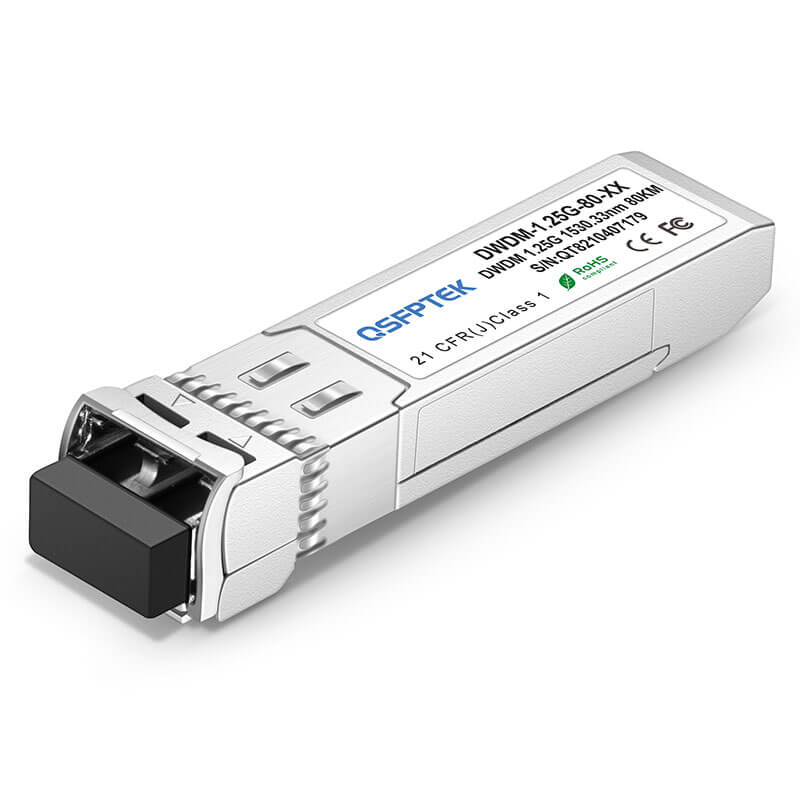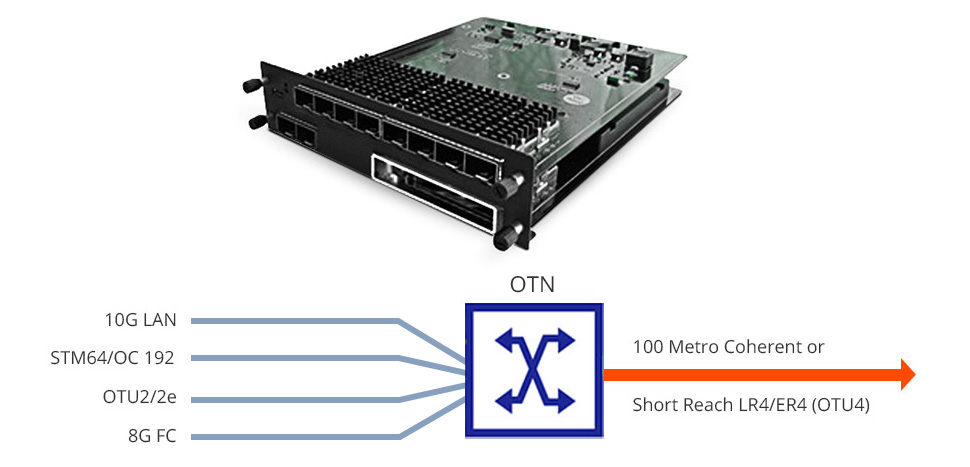Transponder (OEO) Fiber Optical repeater for DWDM system
An optical transponder is a specialized optical-electrical-optical (OEO) device that is used in wavelength division multiplexing (WDM) network systems. Its main function is to receive and transmit optical signals across different wavelengths. Optical transponders typically use either a semiconductor optical amplifier (SOA) or a laser as the optical source. In most cases, they also include an electro-absorption modulator (EAM), which is used to modulate the optical signal. This post will introduce the optical transponder in detail.
What Is Optical Transponder (OEO)?
The optical transponder is a key piece of equipment in optical communication systems. It is responsible for converting the optical signal into an electrical signal, amplifying the electrical signal, and then converting it back into an optical signal. The optical transponder can also extend the transmission distance of the optical signal by using optical-to-electrical-to-optical conversion.
This allows the optical signal to be transmitted over longer distances without losing any of its integrity. The optical transponder can also convert the optical signal from standard optical wavelengths into an optical CWDM or DWDM signal. CWDM signals are less sensitive to dispersion than standard optical signals and can therefore be transmitted over longer distances. DWDM signals are even less sensitive to dispersion than CWDM signals and can therefore be transmitted over even longer distances.
In the process of optical transponder regenerating the signal, it allows the optical signal to be reshaped, retimed, and reamplified. This approach allows the optical transponder to monitor, clean up, and amplify the signal more accurately.

Figure 1: Optical Transponder
Why Do We Need an Optical Transponder (OEO) in WDM System?
In a wavelength-division multiplexing (WDM) system, different devices might use different wavelengths of light. However, sometimes these different devices need to communicate with each other, and the different wavelengths can cause incompatibilities. Additionally, an optical transponder (OEO) can help to resolve these incompatibilities by converting the different wavelengths into a single wavelength that can traverse one fiber optic network to another. This allows different devices to communicate with each other seamlessly, regardless of the different standards between different fiber networks. As a result, OEOs are an essential component of any WDM system. Generally, we divide optical transponder into three different models depending on the type of conversion
Convert Multimode to Single-mode Fiber
Among the two different modes of optical fiber, multimode fiber is used for short-haul transmission and single-mode fiber is generally used for long-haul transmission. If we need to transmit data over distances that exceed the multimode transmission distance limit, or if we need to establish data transmission links between single-mode and multimode devices, then we have to perform mode conversion, otherwise, they cannot interoperate data. The following picture shows how to connect two switches at a distance by two optical transponders while converting multimode fiber to single-mode fiber. This connection mode is generally used to extend the 10G optical transport network (OTN) and synchronous optical network (SONET).

Figure 2: Multimode to Single-mode Fiber Conversion
Convert Dual Fiber to Single Fiber
Single fiber generally operates on BiDi networks, which are able to use two different wavelengths on the same strand of fiber through bi-directional (BiDi) transmission, while dual fiber uses the same wavelength on two different fibers. When converting between dual fiber and single fiber, you can use two optical transponders to do the job, when converting two long-distance dual fiber switches connected by two optical transponders. BiDi single fiber runs two different wavelengths on one fiber, the transmit (Tx) at one end of the fiber and the receive (Rx) at the other end and vice versa.

Figure 3: Dual Fiber to Single Fiber Conversion
Convert Wavelengths
network systems. Fiber optic network equipment with fixed fiber interfaces using conventional wavelengths must be converted to CWDM or DWDM wavelengths through an optical transponder. In the image below, wavelength conversion is accomplished by using an SMF SFP+ and a 1530nm CWDM SFP+ optical module, thus connecting the 10G switch to the CWDM Mux/Demux together. The network requires a 10G switch with a 1310nm signal output to a CWDM Mux/Demux with a 1530nm wavelength, thus connecting the 10G switch to the CWDM Mux/Demux together. With this optical transponder in place, you can complete wavelength conversion, as the signal can be passed through at the required wavelength. This offers a much more efficient way of operating a WDM system, as well as being far less expensive.

Figure 4: Different Wavelengths Conversion
Transponder vs. Transceiver and Muxponder
Transponders and Transceivers are devices that are used to connect two different types of networks so that they can communicate with each other. A Transceiver is a device that can both transmit and receive data, while a Transponder only receives data. Both Transponders and Transceivers can be used to convert data from one form to another. For example, a Transponder can be used to convert electrical signals into optical signals, and a transceiver can be used to convert optical signals to another wavelength of optical signals. Transceivers are typically used in long-distance applications, while Transponders are typically used in short-distance applications.
A Muxponder is a device that multiplexes (or combines) multiple signals into a single signal. Muxponders are similar to Transceivers in that they can both transmit and receive data, but they are specifically designed to multiplex signals. Muxponders are typically used in long-distance applications where multiple signals need to be combined into a single signal.
While Transponders, Transceivers, and Muxponders all have similarities in their functionality, they are essentially different devices considering their designed purposes. Transponders are designed for short-distance applications, Transceivers are designed for long-distance applications, and Muxponders are designed for combining multiple signals into a single signal.
An 8-port four channels multi-rate WDM transponder converts multimode 1Gbps or 10Gbps signals to Singlemode CWDM/DWDM wavelengths, by which the maximum distance of the 1G/10G link can be extended. In this link, only the signal is amplified and the data rate does not change before and after the signal conversion.

Figure 5: A 8-port four channels Transponder
WDM fiber optic transceivers that contain CWDM/DWDM transceiver modules can be used to transmit and receive optical signals of specific wavelengths. They only negatively transmit the signal without changing its mode, wavelength, or speed.

Figure 6: A DWDM SFP optical module
In the case of fiber Muxponders, they are multi-protocol, multi-stage devices that consolidate several different types of services onto a single fiber. For instance, a 100Gbps Muxponder with 10x10G SFP+ and 1x100G CFP connectors can consolidate up to 10 separate standards of 10G signals onto a single 100G signal.

Figure 7: 100G Multiprotocol Multirate Muxponder
Standalone or Line Card WDM Transponder, Which to Choose?
When it comes to WDM transponders, there are two main types: standalone and line cards. Standalone transponders are standalone devices that can be rack-mounted or desktop type. Line card transponders, on the other hand, are integrated into line cards that are installed in chassis. So, which one should you choose?
There are a few things to consider when making your decision. First, think about the amount of space you have in your data center. If you have limited space, then a line card transponder may be the better option since it won't take up as much space as a standalone transponder. Second, consider your budget. Line card transponders tend to be cheaper than standalone transponders in the same size. Finally, think about your specific needs. If you need a higher port density or want to take advantage of advanced features, then a line card transponder may be the better option.
Conclusion
When faced with transmitting signals between different devices, you have to think about whether they are compatible with each other and whether you need an optical transponder for data conversion. In this article, we introduce several common optical transponders for data conversion, including single-mode fiber to multimode fiber conversion, dual-fiber to single-fiber conversion, and conversion between different wavelengths. It is important to note that the optical transponder is only responsible for re-amplifying, monitoring, and cleaning the signal, and the transmission rate is not changed. With an optical transponder, we can extend the transmission distance of the optical transmission link. If you would like to know more, please contact QSFPTEK via [email protected]. We can provide you with optical transponders and a wide range of optical modules, welcome to get a quote!










